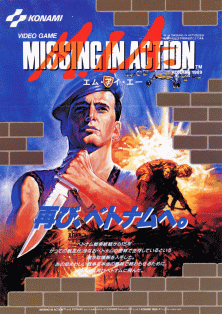Missing in Action (video game)
| green beret 2 | |
|---|---|
 | |
| Developer(s) | Konami |
| Publisher(s) | Konami |
| Platform(s) | Arcade |
| Release date(s) | January 1989[1] |
| Genre(s) | Run and gun |
| Mode(s) | Up to 2 players simultaneously |
| Cabinet | Upright |
| Arcade system | Konami Twin16 (JP) / TMNT (US) Hardware |
| Display | Raster resolution, Horizontal |
M.I.A.: Missing in Action is platform arcade game released by Konami in 1989. The game is a spiritual successor to Green Beret (also known as Rush'n Attack).
The game is influenced by popular action movies of the time such as Commando, Rambo: First Blood Part II, and Missing in Action.
Missing in Action was made available on Microsoft's Game Room service for its Xbox 360 console and for Windows-based PCs on December 15, 2010.
Gameplay
The player takes on the role of a US Army special operations soldier infiltrating enemy POW camps in Vietnam to find prisoners of wars and lead them to freedom. Like its predecessor, there are a total of six levels in the game: war-torn field, jungle, airstrip, rail-yard, POW camp, and escaping POW camp. M.I.A. can be played by up to two players, with Player 1 in green and Player 2 in blue.
Throughout most of the game, the player's main weapon is a knife, which is capable of destroying any enemy in the game. By killing the red enemy soldiers, the player can acquire additional weapons. The available weapons consist of an assault rifle (12 rounds), a flamethrower (2 rounds), a bazooka (3 rounds), and grenades (3 rounds). Unlike Green Beret, the player can carry more than one weapon and switch between them at will. If the player loses a life, then only their currently equipped weapon will be lost.
At the end of each level, an assorted amount of troops on fixed machine gun positions (usually four) that must be eliminated. On the last mission of the game, the freed hostages are susceptible to being slain by enemies; if all the POW's get killed then "MISSION FAILED" flashes on the screen and the game is permanently over.
Versions
There were three versions of M.I.A.: Versions S and T, which were produced for the American and international markets, a Japanese version. In some versions, the order of the first four stages are randomized. In the Japanese version, the every second stage scrolls from left-to-right instead of right-to-left like in the international versions.
References
- ↑ Missing in Action at Gaming-History